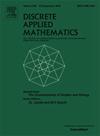图的收费步行运输函数:公理化表征和一阶不可定义性
IF 1
3区 数学
Q3 MATHEMATICS, APPLIED
引用次数: 0
摘要
如果图G中w1≠wk,且w2(wk−1)是w1(wk)在W上的唯一邻居,则W=w1w2…wk, k≥2称为收费步行。收费步行区间T(u,v), u,v∈v (G),包含u和v之间属于收费步行的所有顶点。收费步行区间产生收费步行运输函数T: v (G)×V(G)→2V(G)。我们给出了几个公理来描述在弦图、树图、三自由度图、托勒密图和距离遗传图之间的收费步行运输函数。我们还证明了对于任意图,收费步行运输函数不能用一阶逻辑语言来描述。本文章由计算机程序翻译,如有差异,请以英文原文为准。
The toll walk transit function of a graph: Axiomatic characterizations and first-order non-definability
A walk , , is called a toll walk if and are the only neighbors of on in a graph . A toll walk interval , , contains all the vertices that belong to a toll walk between and . The toll walk intervals yield a toll walk transit function . We represent several axioms that characterize the toll walk transit function among chordal graphs, trees, asteroidal triple-free graphs, Ptolemaic graphs, and distance-hereditary graphs. We also show that the toll walk transit function cannot be described in the language of first-order logic for an arbitrary graph.
求助全文
通过发布文献求助,成功后即可免费获取论文全文。
去求助
来源期刊

Discrete Applied Mathematics
数学-应用数学
CiteScore
2.30
自引率
9.10%
发文量
422
审稿时长
4.5 months
期刊介绍:
The aim of Discrete Applied Mathematics is to bring together research papers in different areas of algorithmic and applicable discrete mathematics as well as applications of combinatorial mathematics to informatics and various areas of science and technology. Contributions presented to the journal can be research papers, short notes, surveys, and possibly research problems. The "Communications" section will be devoted to the fastest possible publication of recent research results that are checked and recommended for publication by a member of the Editorial Board. The journal will also publish a limited number of book announcements as well as proceedings of conferences. These proceedings will be fully refereed and adhere to the normal standards of the journal.
Potential authors are advised to view the journal and the open calls-for-papers of special issues before submitting their manuscripts. Only high-quality, original work that is within the scope of the journal or the targeted special issue will be considered.
 求助内容:
求助内容: 应助结果提醒方式:
应助结果提醒方式:


